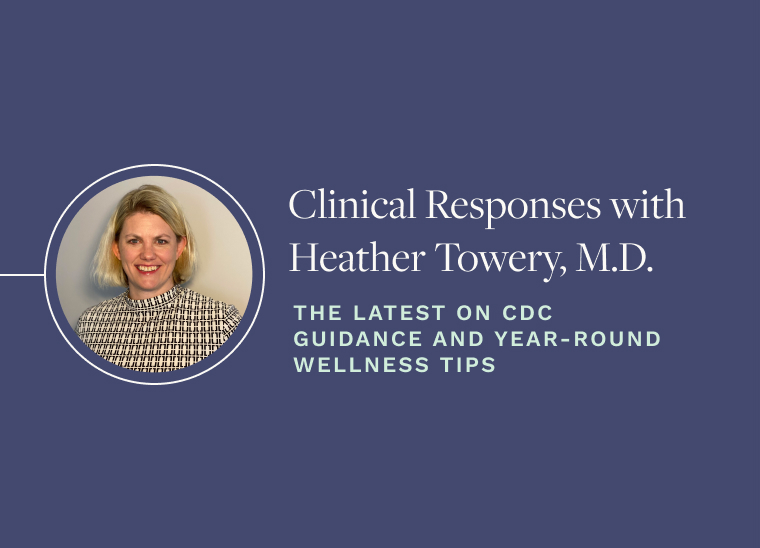As we move into February, we’ll continue to update you about the pandemic and also include information on how you can best support your employees’ health and wellbeing throughout the year.
Find our latest COVID-19 updates and additional health and wellness tips below:
COVID-19 UPDATE
- Omicron is still surging in several states, but we are seeing evidence that it is starting to subside in some parts of the country. In the Northeast and Midwest, positivity rates and hospitalizations are declining steadily. However, hospitalizations on the west coast are still increasing. While there is no official consensus yet, there is general optimism among the medical and scientific communities that we will see a lull in COVID-19 infections by spring.
- BA.2, an Omicron subvariant, is now present in 40 countries including the United States. It’s not clear where the new variant first emerged, but because viruses are always mutating, a new variant isn’t unexpected. The World Health Organization (WHO) has not identified BA.2 as a variant of concern but has instructed scientists to closely monitor the variant. Early indications are that BA.2 can spread at least as fast as Omicron if not faster, but it does not seem to cause more severe illness than Omicron. Scientists will need more time and data to learn how BA.2 will manifest itself.
CDC UPDATES REGARDING COVID-19 VACCINATION STATUS
- Defining “Up to Date” Vaccinations: The Centers for Disease Control and Prevention (CDC) has defined what being “up to date” on one’s COVID-19 vaccines means. It’s important to understand this definition to determine how quarantine rules apply after exposure to COVID-19. Additionally, many employers are requiring boosters to be considered fully vaccinated to return to the office.
- From the CDC: Everyone is considered up to date until the time they are eligible for a booster, which is five months after the second dose in a two-shot series, (such as the Pfizer-BioNTech or Moderna vaccines) and two months after the J&J/Janssen one-shot vaccine. After this period of time, a booster shot is recommended and a person is no longer up to date on their recommended COVID-19 vaccination. To be considered up to date, a person would need to get a booster shot.
- Ongoing exposure: The CDC also provided guidance for those who have ongoing exposure to COVID-19 because someone they live with has COVID-19. The recommendations depend on vaccination status. From the CDC:
If you are NOT up to date on COVID-19 vaccines and have ongoing exposure to COVID-19, you should:
- Begin quarantine immediately and continue to quarantine throughout the isolation period of the person with COVID-19.
- Continue to quarantine for an additional 5 days starting the day after the end of isolation for the person with COVID-19.
- Get tested at least 5 days after the end of isolation of the infected person that lives with them.
- If you test negative, you can leave the home but should continue to wear a well-fitting mask when around others at home and in public until 10 days after the end of isolation for the person with COVID-19.
You should isolate immediately if you develop symptoms of COVID-19 or test positive.
If you are up to date with COVID-19 vaccines and have ongoing exposure to COVID-19, you should:
- Get tested at least 5 days after your first exposure. A person with COVID-19 is considered infectious starting 2 days before they develop symptoms, or 2 days before the date of their positive test if they do not have symptoms.
- Get tested again at least 5 days after the end of isolation for the person with COVID-19.
- Wear a well-fitting mask when you are around the person with COVID-19, and do this throughout their isolation period.
- Wear a well-fitting mask around others for 10 days after the infected person’s isolation period ends.
You should isolate immediately if you develop symptoms of COVID-19 or test positive.
HEALTHY EMPLOYEES IN 2022
As you review your claims data from the last 12 – 24 months, you may continue to see patterns that began in 2020 as a result of COVID-19, such as fewer preventive care services, gaps in care for chronic conditions, and elevated mental health utilization. While the use of medical services has rebounded from the earliest days of the pandemic, there is still some disruption to usual patterns of care as providers and the health system adapt in response to the pandemic. While we don’t know when or how the pandemic will end, we do know it’s vital to be as healthy as possible both physically and mentally as we continue to live with COVID-19 and the many other viruses that can make us ill and disrupt our daily lives from time to time.
Eden Health can provide virtual care in addition to in-person care and can quickly get your employees back on track with their health goals, whether through preventive screening, mental health services, annual physicals, or addressing seasonal concerns such as how to distinguish between a common cold, the flu, or COVID-19. The beginning of the year is a good time to encourage employees to make their health a priority by reminding them to schedule their annual appointments and check in with their primary care provider.
Want to learn more about how Eden’s collaborative care model keeps your employees healthy year-round? Request a demo from a member of our team today.
Disclaimer: This information is based on current resources available and is subject to change. This document and its contents are provided for informational purposes only, and not intended to be, and should not be understood or treated as, a substitute for professional medical advice around COVID-19, its risks or symptoms, or to take the place of any local, state and national laws and guidelines around COVID-19. Always seek the advice of a physician or other qualified health provider with any questions you may have regarding a medical condition.





